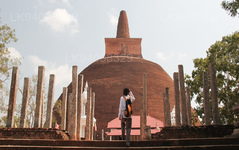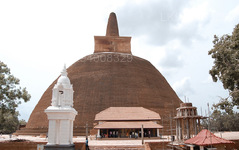
アヌラーダプラの宿泊施設
아누라다푸라는 스리랑카 북중부 지방에 속합니다. 아누라다푸라는 스리랑카의 고대 수도 중 하나로, 잘 보존된 고대 스리랑카 문명 유적지로 유명합니다. 현재 유네스코 세계문화유산으로 지정된 이 도시는 스리랑카의 현재 수도 콜롬보에서 북쪽으로 205km 떨어져 있습니다.
Abhayagiri Dagoba
Abhayagiri Vihāra was a major monastery site of Mahayana, Theravada and Vajrayana Buddhism that was situated in Anuradhapura, Sri Lanka. It is one of the most extensive ruins in the world and one of the most sacred Buddhist pilgrimage cities in the nation. Historically it was a great monastic centre as well as a royal capital, with magnificent monasteries rising to many stories, roofed with gilt bronze or tiles of burnt clay glazed in brilliant colors. To the north of the city, encircled by great walls and containing elaborate bathing ponds, carved balustrades and moonstones, stood "Abhayagiri", one of seventeen such religious units in Anuradhapura and the largest of its five major viharas. One of the focal points of the complex is an ancient stupa, the Abhayagiri Dagaba. Surrounding the humped dagaba, Abhayagiri Vihara was a seat of the Northern Monastery, or Uttara Vihara and the original custodian of the Tooth relic in the island.
The term "Abhayagiri Vihara" refers not only to the complex of monastic buildings, but also a fraternity of Buddhist monks, or Sangha, which maintained its own historical records, traditions and way of life. Founded in the 2nd century BC, it had grown into an international institution by the 1st century AD, attracting scholars from all over the world and encompassing all shades of Buddhist philosophy. Its influence can be traced to other parts of the world, through branches established elsewhere. Thus, the Abhayagiri Vihara developed as a great institution vis‑a‑vis the Mahavihara and the Jetavana Buddhist monastic sects in the ancient Sri Lankan capital of Anuradhapura.
It is recorded in the chronicle that Abhayagiri Dagaba was established by King Valagamba during the period of his second reign, from 89-77 B.C.E. A young Brahmin named Tiya (Tissa) declared war against him. Tiya was deluded by the prophecy of another Brahmin that was destined to be king. Before the arrival of Bhikkhu Mahinda, who brought Buddhism to the island, Brahmins held the highest place in society. After the establishment of the Buddhist sangha on the island, however, they lost their supremacy, and were replaced by the sangha. Some Brahmins converted to Buddhism, while others revolted. Tiya, who enjoyed the support of his community, lived both in and outside of Sri Lanka, and was therefore very powerful.
아누라다푸라 지구 소개
아누라다푸라는 스리랑카 북중부 지방에 속합니다. 아누라다푸라는 스리랑카의 고대 수도 중 하나로, 잘 보존된 고대 스리랑카 문명 유적지로 유명합니다. 현재 유네스코 세계문화유산으로 지정된 이 도시는 스리랑카의 현재 수도 콜롬보에서 북쪽으로 205km 떨어져 있습니다. 신성한 도시 아누라다푸라와 그 주변에는 수많은 유적이 있습니다. 유적은 다고바, 수도원, 그리고 포쿠나(연못)의 세 가지 유형의 건물로 구성되어 있습니다. 이 도시는 고대 세계에서 가장 복잡한 관개 시스템을 갖추고 있었으며, 국가의 건조 지대에 위치해 행정부는 토지에 관개를 위해 많은 탱크를 건설했습니다. 대부분의 민간인은 싱할라족이며, 타밀족과 스리랑카 무어족이 이 지역에 거주합니다.
북중부 지방 소개
북중부 지방은 이 나라에서 가장 큰 지방으로 전체 국가 면적의 16%를 차지했습니다. 북중부 지방은 폴로나루와와 아누라다푸레라는 두 개의 지구로 구성되어 있습니다. 아누라다푸라는 스리랑카에서 가장 큰 지구입니다. 면적은 7,128km²입니다. 북중부 지방은 투자자들이 사업을 시작할 수 있는 수많은 잠재력을 가지고 있으며, 특히 농업, 농업 기반 산업 및 축산 분야가 그렇습니다. 북중부 지방 주민의 65% 이상이 기초 농업 및 농업 기반 산업에 의존합니다. NCP는 이 지방에 중대형 탱크가 3,000개 이상 있기 때문에 "웨우 벤디 라제"라고도 불립니다. 스리 마하 보디야, 루완웰리 세야, 투파라마 다게바, 아바야기리 수도원, 폴로나루와 랑코트 웨헤라, 란카티레이크가 두렵습니다.














